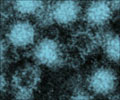
The research was published today in the peer-reviewed journal Cell.
"These findings open doors to developing new drugs against Ebola," added Zachary Bornholdt, Ph.D., senior staff scientist and first author of the study. "Drugs to block viral replication could target any of the structures themselves or the intermediate steps in the structural transformation process."
Ebola hemorrhagic fever is one of the most virulent diseases known to humankind. Very few pathogens prove more dangerous than Ebola virus once a person is infected. There is no cure, and the case-fatality rate can be up to 90 percent, depending on which strain is involved.
Ebola virus and its cousin Marburg virus are spread when people come into contact with the bodily fluids of a person or animal who is already infected. Infection causes rapidly progressing high fever, hemorrhage and shock. No drugs or vaccines are yet available for human use. Currently, the standard treatment consists of administering fluids and taking protective measures to ensure containment, such as isolating the patient and washing sheets with bleach.
Once rare, the viruses are now reemerging with increasing frequency, and have caused at least four outbreaks among humans in the last two years. Although the viruses are found most often in Africa, they have been unintentionally imported into the United States and Europe several times, and in recent years a version of the Ebola virus has been found replicating in swine raised for human consumption in Asia.
Advertisement
The results, five years in the making, revealed the Ebola VP40 protein exists as a dimer, not as a monomer as previously thought, and it rearranges its structure to assemble filaments to build the virus shell or "matrix" to release countless new viruses from infected cells. The study showed the protein also rearranges itself into rings in order to bind RNA and control the internal components of the virus copied inside infected cells.
Advertisement
Source-Eurekalert












